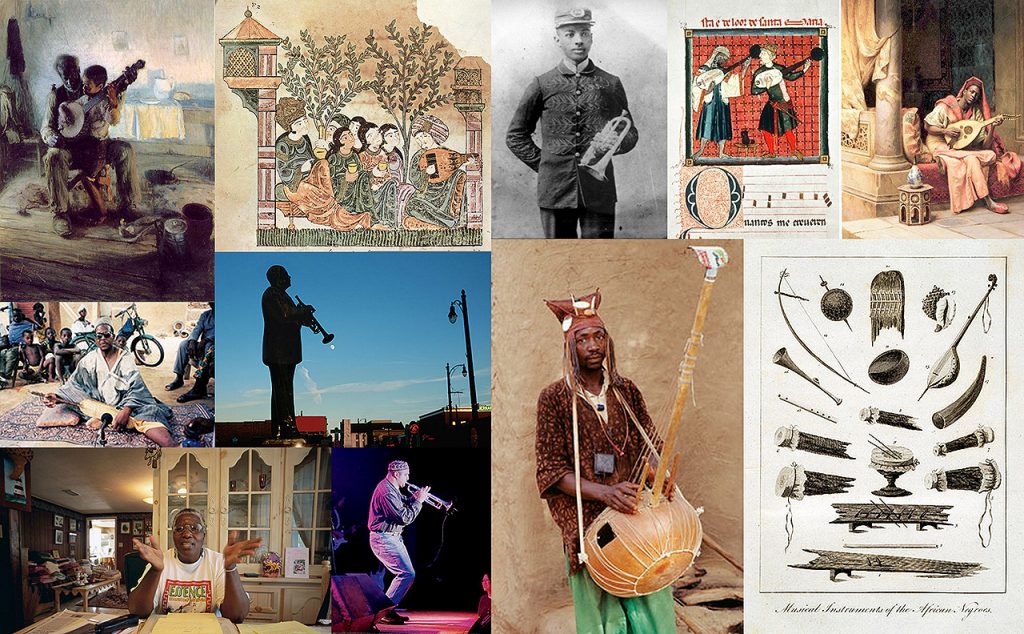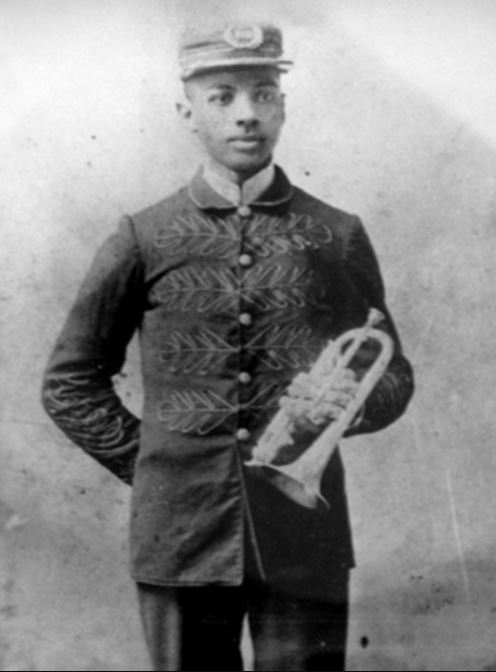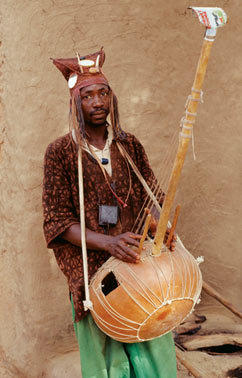

Muslim Roots, U.S. Blues
by Jonathan CurielPublished on: 19th June 2020
To many the idea that American blues music has its origins with Muslims and even the Islamic call to prayer is inconceivable. It is also largely unknown that up to thirty percent of enslaved Americans, the sources of blues music were in fact African Muslims. This fascinating article delves deeper into the historical input of Muslims to the American blues genre.

***
Note of the Editor: First published in Saudi Aramco World. July / August 2006. Then published in Muslim Heritage also (17 Nov 2006 and 2014).
***
Sylviane Diouf knows her audience might be skeptical, so to demonstrate the connection between Muslim traditions and American blues music, she’ll play two recordings: The adhan, the Muslim call to prayer that’s heard from minarets around the world, and “Levee Camp Holler,” an early type of blues song that first sprang up in the Mississippi Delta more than 100 years ago.

Figure 2. W. C. Handy, “Father of the Blues” and a son of former slaves, recorded a 1903 encounter with a man playing an instrument that was evolving from an African zither into an American slide guitar.
“Levee Camp Holler” is no ordinary song. It’s the product of formerly enslaved people who worked moving earth all day in post-Civil War America. The version that Diouf uses in presentations has lyrics that, like the call to prayer, speak about a glorious God. But it’s the song’s melody and note changes that closely resemble one of Islam’s best-known refrains. Like the call to prayer, “Levee Camp Holler” emphasises words that seem to quiver and shake in the reciter’s vocal chords. Dramatic changes in musical scales punctuate both “Levee Camp Holler” and the adhan. A nasal intonation is evident in both.
“I did a talk a few years ago at Harvard where I played those two things, and the room absolutely exploded in clapping, because [the connection] was obvious,” says Diouf, an author and scholar who is also a researcher at New York’s Schomburg Center for Research in Black Culture. “People were saying, ‘Wow. That’s really audible. It’s really there.” It’s really there thanks to all the enslaved Muslims from West Africa who were taken by force to the United States for three centuries, from the 1600’s to the mid-1800’s. Upward of 30 percent of the enslaved Africans in the United States were Muslim, and historians now say an untold number of them spoke and wrote Arabic. Despite being pressured by slave owners to adopt Christianity and give up their old ways, many of these slaves continued to practice their religion and customs, or otherwise melded traditions from Africa into their new environment in the antebellum South. Forced to do menial, backbreaking work on plantations, for example, they still managed, throughout their days, to voice a belief in God and the revelation of the Qur’an. The practice of these enslaved peoples’ eventually evolved — decades and decades later, parallel with different singing traditions from Africa — into the shouts and hollers that begat blues music, Diouf and other historians believe.

Figure 2. “History changes things,” says author Cornelia Walker Bailey, (above) who lives on Sapelo Island, Georgia. Her surname started out as Bilali, the given name of her ancestor Bilali Mohammed. Trained as a Muslim prayer leader in his native Guinea, he was enslaved in 1803 and brought to Sapelo Island, where a small community of his descendants still lives. Bailey grew up saying Christian prayers facing east, the direction of Makkah—the same direction in which her Muslim ancestor prayed

African Muslim slaves influenced later blues both through their musical style and through their instruments, which, in late-18th-century Suriname, included percussion, wind and string devices. Among the latter were a one-string benta (top left), and a Creole-bania (top right), an ancestor of the American banjo.
Another way that Muslim slaves had an indirect influence on blues music is the instruments they played. Drumming, which was common among slaves from the Congo and other non-Muslim regions of Africa, was banned by white slave owners, who felt threatened by its ability to let enslaved people communicate with each other and by the way it inspired large gatherings of them.
Stringed instruments, however — favored by enslaved peoples from the Muslim regions of Africa, where there’s a long tradition of musical storytelling — were generally allowed because slave owners considered them akin to European instruments such as the violin. Hence, the enslaved people who managed to cobble together a banjo or other instrument — the American banjo originated with enslaved Africans — could play more widely in public. This solo-oriented slave music featured elements of an Arabic–Muslim song style that had been imprinted by centuries of Islam’s presence in West Africa, says Gerhard Kubik, a professor of ethnomusicology at the University of Mainz in Germany. Kubik has written the most comprehensive book on Africa’s connection to blues music, Africa and the Blues (1999, University Press of Mississippi).
Kubik believes that many of today’s blues singers unconsciously echo these Arabic–Muslim patterns in their music. Using academic language to describe this habit, Kubik writes in Africa and the Blues that:
“the vocal style of many blues singers using melisma, wavy intonation, and so forth is a heritage of that large region of West Africa that had been in contact with the Arabic–Islamic world of the Maghreb since the seventh and eighth centuries.”
(Melisma is the use of many notes in one syllable; wavy intonation refers to a series of notes that veer from major to minor scale and back again, something that’s common in both blues music and in the Muslim call to prayer as well as recitation of the Qur’an. The Maghreb is the Arab–Muslim region of North Africa.)
Kubik summarises his thesis this way:
“Many traits that have been considered unusual, strange and difficult to interpret by earlier blues researchers can now be better understood as a thoroughly processed and transformed Arabic–Islamic stylistic component.”

Figure 3. “Bayad plays the oud to the lady”,Arabic manuscript for Qissat Bayad wa Reyad tale (late 12th century) (Source)
The extent of this link between Muslim culture and American blues music is still being debated. Some scholars insist there is no connection, and many of today’s best-known blues musicians would say their music has little to do with Muslim culture. Yet a growing body of evidence — gathered by academics such as Kubik and by others such as Cornelia Walker Bailey, a Georgia author whose great-great-great-great-grandfather was enslaved prayed toward Makkah — suggesting a deep relationship between enslaved people of Islamic descent and US culture. While enslaved Muslims from West Africa were just one factor in the formation of American blues music, they were a factor, says Barry Danielian, a trumpeter who’s performed with Paul Simon, Natalie Cole and Tower of Power.

Figure 4. The largest of the banjo ancestors is the kora of the Mandinka people in today’s Senegal, Guinea-Conakry and Gambia. It traditionally uses 21 strings and a large calabash-gourd body.
Danielian, who is Muslim, says non-Muslims find this connection hard to believe because they don’t know enough about Arabic or Muslim music. The call to prayer and other Muslim recitations that were practiced by enslaved Americans had a musicality to them, just as these recitations still do, even if they aren’t thought of as music by westerners, Danielian says, who lives in Jersey City, New Jersey.
“In my congregation, when we get together, especially when the shaykhs [leaders] come and there are hundreds of people and we do the litanies, they’re very musical. You hear what we as Americans would call soulfulness or blues. That’s definitely in there.”
What people now think of as blues music developed in the 1890’s and early 1900’s, in Southern US states such as Louisiana, Mississippi and Alabama. Blues music was an outgrowth of all the different music that was then being performed in the South, from minstrels to street shows. Early blues performers didn’t recognize the music’s African or Muslim roots because, by then, the songs had more fully merged with white, European music and had lost their obvious connections to a continent that was 4000 miles away. Also, by the turn of the 20th century, the progeny of America’s enslaved Muslims had generally converted to Christianity, either by force or circumstance. Among Southern Blacks in that period, there were few exponents of Islam. But as more scholars research that period in history, they see plenty of signs that weren’t obvious 100 years ago.
Take the case of W. C. Handy, who earned the moniker “Father of the Blues” for the way he formalised blues music over a 40-year career of writing songs and playing the cornet. In his autobiography, Handy, whose parents were enslaved, writes about a life-changing moment that happened to him around 1903. Handy was sleeping at a train station in Tutwiler, Mississippi when:
“a lean, loose-jointed Negro had commenced plucking a guitar beside me while I slept. His clothes were rags; his feet peeped out of his shoes. His face had on it some of the sadness of the ages. As he played, he pressed a knife on the strings of the guitar…. The effect was unforgettable. His song, too, struck me instantly…. The singer repeated the line (“Goin’ where the Southern cross’ the Dog”) three times, accompanying himself on the guitar with the weirdest music I had ever heard.”
The song was about a nearby train station where different train lines intersected. As Handy noted in the autobiography, published in 1941:
“Southern Negroes sang about everything. Trains, steamboats, steam whistles, sledgehammers, fast women, mean bosses, stubborn mules—all became subjects for their songs. They accompany themselves on anything from which they can extract a musical sound or rhythmical effect, anything from a harmonica to a washboard. In this way, and from these materials, they set the mood for what we now call the blues.”

Figure 5. The West African lute known as the ngoni is played in the “clawhammer style” formerly popular for playing today’s banjos. For almost every note of the scale, there is a different tuning for the ngoni and a different pattern of playing.
While washboards, in fact, became popular among later blues musicians such as Robert Brown (known as “Washboard Sam”), the technique that Handy witnessed — that of pressing the back of a knife blade on guitar strings — can be traced to Central and West Africa, where, as Kubik points out in Africa and the Blues, people play one-string zithers that way. Handy assumed that the technique, now called “slide guitar,” was borrowed from Hawaiian guitar playing, but it’s more likely that the itinerant guitar player that Handy met in Tutwiler was manifesting his African roots. Kubik has traveled to Africa many times for his research and has lived there.
Bailey, who visited West Africa in 1989, says the African and Muslim roots of Southern US traditions are often mistaken for something else.
Bailey lives on Georgia’s Sapelo Island, where some blacks can trace their ancestry to Bilali Mohammed, an enslaved Muslim who was born and raised in what is now the African nation of Guinea. Visitors to Sapelo Island are always struck by the fact that churches there face east. In fact, as a child, Bailey learned to say her prayers facing east—the same direction that her great-great-great-great-grandfather faced when he prayed toward Makkah.
Bilali was an educated man. He spoke and wrote Arabic, carried a Qur’an and a prayer rug, and wore a fez that likely signified his religious devotion. Bilali had been trained in Africa to be a Muslim leader; on Sapelo Island, he was appointed by his slave master to be an overseer of other enslaved people. Although Bilali’s descendents adopted Christianity, they incorporated Muslim traditions that are still evident today.

Figure 6. To trumpeter Barry Danielian, Muslim prayers are “very musical. You hear what we as Americans would call soulfulness or blues. That’s definitely in there.
The name Bailey, in fact, is a reworking of the name Bilali, which became a popular Muslim name in Africa because one of Islam’s first converts — and the religion’s first muezzin — was a former Abyssinian slave named Bilal (Muezzins are those who call Muslims to prayer.) One historian believes that abolitionist Frederick Douglass, who changed his name from Frederick Bailey, may also have had Muslim roots, who chronicled the history of Sapelo Island in her memoir God, Dr. Buzzard, and the Bolito Man (2001, Anchor):
“History changes things, Things become something different from what they started out as.”
A good example is the song “Little Sally Walker.” It’s been recorded by many blues artists, but it’s also been recorded as “Little Sally Saucer” because the lyrics describe a girl “sittin’ in a saucer.” Frankie Quimby, a relative of Bailey’s who also traces her roots to Bilali Mohammed, says the song originated during slavery on the Georgia coast, written by song writing slaves who took their slaveholder’s last name, Walker, as their own. “I’ve seen [people] take the song and use different words,” says Quimby, who sings songs about enslaved people with her husband in a group called the Georgia Sea Island Singers.

Figure 7. The Banjo Lesson, Henry Ossawa Tanner, 1893 (Source)
Due to there being little documentation about these slave-time origins, it’s easy to argue about what can be unequivocally linked to Africa and Muslim culture. Muslim and Arab culture have certainly been influences on other music around the world, including flamenco, which is rooted in seven centuries of Muslim rule in Spain, and Renaissance music. So far, knowledge of Muslim culture’s association with blues music seems limited to a select group of academics and musicians. Books such as Kubik’s Africa and the Blues and Diouf’s Servants of Allah: African Muslims Enslaved in the Americas (1998, New York University Press) are more geared toward university audiences.
In terms of popular culture, it’s hard to find a single work — whether it’s a novel, movie, song or other art form — that covers the intersection of Muslim culture, music and enslaved Africans. “Daughters of the Dust,” Julie Dash’s 1991 film about life on the Sea Islands of Georgia, features a Muslim man who portrays Bilali Mohammed, but a scene that shows him in prayer lasts just a few moments, and the movie received limited release.
Roots, Alex Haley’s novel that was made into a historic television series in the 1970’s, featured a main character (Kunte Kinte) who is Muslim, although novelist James Michener and others doubted the authenticity of Haley’s work.
The trading of ensalved Africans led to a diaspora unlike any other in human history, with at least 10 million Africans bought and sold into bondage in the Americas. The pain felt by those slaves is evident in American blues music — a music that’s often about cruel treatment, sad times and a yearning to break free. Blues music is a unique American art form that went around the world and, in turn, influenced history. Without the blues, there wouldn’t be jazz and there wouldn’t be the bluesy music of the Rolling Stones and the Beatles.

Figure 8. In the Memphis city park that carries his name, a statue of W. C. Handy commemorates his introduction of the blues along the city’s famously musical Beale Street.
In his book Black Music of Two Worlds (1998, Schirmer), author John Storm Roberts says he can hear patterns of African Muslim music in the songs of Billie Holiday. Roberts refers to the “bending of notes” that is evident in Holiday’s sad, soulful ballads, as it is in the call to prayer. This same note-bending can be heard in the music of B. B. King and John Lee Hooker.
Blues music, with its strong tempos and many lyrical references to relationships, has been described as “the devil’s music” by those outside it. Many conservative Muslims think of blues music as decadent and indicative of permissive western morals. But people such as Diouf, Kubik and Moustafa Bayoumi, an Associate Professor of English at Brooklyn College, City University of New York, who has researched Muslim culture’s connection to American music, are trying to correct the public record. Bayoumi wrote a paper several years ago that examined African Muslim history in the United States. In it, he argues that John Coltrane’s best-known album, “A Love Supreme,” features Coltrane saying, “Allah supreme” in addition to the many refrains of “a love supreme.”. Bayoumi, asked about the spate of new scholarship on the subject of Islam and African–Americans, says:
“It’s about uncovering a hidden past, You can hear [influences of Muslim culture] in even the earliest days of American blues music. What you’ve gotten lately is an ethnomusicology that’s trying to reconstruct that. These are deliberate attempts to rebuild a bridge, as it were.”
Written by Jonathan Curiel, ‘Muslim Roots, U.S. Blues,’ Saudi Aramco World. July / August 2006

Figure 9. (Left) A Muslim and a Christian playing a duet on the lute in 13th-century Spain. This work was dedicated to Alfonso the Wise, the Christian ruler of Castile, Leon, and Galicia (Right) Imaginary Potrait of Ziryab – An Anonymous Personality in European history (Source)






















No hay comentarios:
Publicar un comentario